Analysis of the Impact of Land-Use/Land-Cover Change on Land-Surface Temperature in the Villages within the Luki Biosphere Reserve
Abstract
:1. Introduction
2. Materials and Methods
2.1. Study Area
2.2. Data Collection and Preprocessing
2.3. Land-Use/Land-Cover Classification
2.4. Estimation of Land Surface Temperature
2.5. Prediction of Land Use/Land Cover
2.5.1. Cellular Automata
2.5.2. Markov Chain Analysis
2.5.3. Implementation of CA–Markov Chain Model
- The computation land-use transition probability matrix and transition rules, using Markov chain analysis. The precedent state of each land-use/land-cover category was used to predict its future state. To predict land-use/land-cover change in 2038, we used the transition probabilities map between 2002 and 2020. Moreover, the land-use/land-cover transformation rules were provided by the transition probability matrices. These matrices provide the description of transition probability of each land-use/land-cover category into others. However, quantities of change in each land-use/land-cover categories to other categories were provided by the transition area matrices.
- Determining the CA filter. Here, several options of standard contiguity kernels were applied as neighborhoods to identify the suitable contiguity filter for the purpose of land-use/land-cover prediction. These are 7 × 7, 5 × 5 and 3 × 3 contiguity kernels. For this study, we selected the contiguity filter 5 × 5. This filter considers that the center of each pixel is surrounded by matrix space of 5 × 5 dimension in order to reflect the change in each pixel significantly.
- Determining the number of iterations and the time of starting point of CA. To identify the suitable iterations, we applied several iteration numbers, starting from 1 to 300. Ultimately, we selected four iterations to carry out the land-use/land-cover change prediction.
2.5.4. Model Validation
3. Results and Discussion
3.1. Land-Use/Land-Cover Change from 2002 to 2020
3.2. Spatiotemporal Distribution of LST and Its Variations with LULC Types
3.3. Variations of LSTs for Different Land Covers
3.4. Variation of LST Changes in Converted Land-Use/Land-Cover Areas
4. Discussions
4.1. Spatiotemporal Distribution of LST and its Variations with LULC Types
4.2. Impact of Land-Use/Land-Cover Change, Climate Change and Land-Surface Temperature in the Villages
Perception of Local Communities on the Impact of Land-Use/Land-Cover Change and Climate Change in the Region
- The present study revealed a major growth of built-up area in all the four villages, which was transformed from forest land, complex degraded and young secondary forest, fallow land and fields, and savannah.
- The highest and lowest land-surface temperature in built-up area and forest land, respectively, were determined for all the years under study. The spatial mean LST significantly increased by 2.28, 1.67, 1.49 and 0.93 °C for the Tsumba kituti, Kisavu, Kiobo and Kibuya villages, respectively.
- Continuous increase in the land-surface temperature was observed in all the land-use/land-cover categories over the years, except for the forest land class. This indicates the effect of the microclimate warming in the four villages. On the other hand, correlation analysis illustrates the gradual increase of land-surface temperature with the increase of built-up area.
- Changes in land use/land cover will continue to be experienced in all the villages (Figure 11 and Figure 12). In Tsumba kituti, the complex of degraded and young secondary forest, forest land and savannah will continue to decrease with 40.8, 36.94 and 16.3 hectares, respectively. Fallow land and field, built-up area will increase with 77.3 and 19.2 hectares, respectively. In Kiobo, forest land will continue to decrease with 19.74 hectares. Additionally, there will be an increase of 23.04, 1.65 and 0.49 hectares for fallow land and fields, complex of degraded and young secondary forest, and built-up area, respectively. In Kisavu, fallow land and fields, built-up area, complex of degraded and young secondary forest will experience an increase of 70.61, 5.54 and 10.63 hectares, respectively. The forest land will decrease by 85.28 hectares. Finally, in Kibuya, built-up and fallow land and fields will experience an increase of 0.75 and 4.04 hectares, respectively; while the forest land will decrease by 4.2 hectares. Consequently, this will impact the variation of land-surface temperature in the future.
- Land-use/land-cover change and climate-change-impacted land-surface temperature in the four villages. According to the perception of local communities, these changes can cause different environmental issues such as biodiversity loss, soil erosion, change in frequency and intensity of precipitation, seasonal variation and increase in temperature. Additionally, this change negatively impacts human health and crop production in the region.
5. Conclusions
Author Contributions
Funding
Institutional Review Board Statement
Informed Consent Statement
Data Availability Statement
Conflicts of Interest
References
- Opelele, O.M.; Ying, Y.; Wenyi, F.; Chen, C.; Kachaka, S.K. Examining Land Use/Land Cover Change and Its Prediction Based on a Multilayer Perceptron Markov Approach in the Luki Biosphere Reserve, Democratic Republic of Congo. Sustainability 2021, 13, 6898. [Google Scholar] [CrossRef]
- Opelele, O.M.; Fan, W.; Yu, Y.; Kachaka, S.K. Analysis of Land Use/Land Cover Change and its Prediction in the Mambasa Sector, Democratic Republic of Congo. Appl. Ecol. Environ. Res. 2020, 18, 5627–5644. [Google Scholar] [CrossRef]
- Al Kafy, A.; Abdullah-Al, F.; Al Rakib, A.; Abdullah Al, R.; Shaleha, K.A.; Zullyadini, A.R.; Dewan, A.J.; Gangaraju, S.; Opelele, O.M.; Abhishek, B. The operational role of remote sensing in assessing and predicting land use/land cover and seasonal land surface temperature using machine learning algorithms in Rajshahi, Bangladesh. Appl. Geomat 2021. [Google Scholar] [CrossRef]
- Chen, X.L.; Zhao, H.; Li, P.; Yin, Z. Remote sensing image-based analysis of the relationship between urban heat island and land use/cover changes. Remote Sens. Environ. 2006, 104, 133–146. [Google Scholar] [CrossRef]
- Lu, Q.; Chang, N.-B.; Joyce, J.; Chen, A.S.; Savic, D.A.; Djordjevic, S.; Fu, G. Exploring the potential climate change impact on urban growth in London by a cellular automata-based Markov chain model, Comput. Environ. Urban Syst. 2018, 68, 121–132. [Google Scholar] [CrossRef]
- Sun, C.; Wu, Z.; Lv, Z.; Yao, N.; Wei, J. Quantifying different types of urban growth and the change dynamic in Guangzhou using multi-temporal remote sensing data. Int. J. Appl. Earth Obs. Geoinf. 2013, 21, 409–417. [Google Scholar] [CrossRef]
- Seto, K.C.; Fragkias, M.; Guneralp, B.; Reilly, M.K. A meta-analysis of global urban land expansion. PLoS ONE 2011, 6, e23777. [Google Scholar] [CrossRef]
- Rajeshwari, A.; Mani, N.D. Estimation of land surface temperature of dindigul district using landsat 8 data. Int. J. Res. Eng. Technol. 2014, 3, 122–126. [Google Scholar]
- Zhang, R.; Matsushima, K.; Kobayashi, K. Can land use planning help mitigate transport-related carbon emissions? A case of Changzhou. Land Use Policy 2018, 74, 32–40. [Google Scholar] [CrossRef]
- Bounoua, L.; Nigro, J.; Zhang, P.; Thome, K.; Lachir, A. Mapping urbanization in the United States from 2001 to 2011. Appl. Geogr. 2018, 90, 123–133. [Google Scholar] [CrossRef]
- Lu, Y.; Wu, P.; Ma, X.; Li, X. Detection and prediction of land use/land cover change using spatiotemporal data fusion and the Cellular Automata–Markov model. Environ. Monit. Assess. 2019, 191, 68. [Google Scholar] [CrossRef]
- Mumtaz, F.; Tao, Y.; de Leeuw, G.; Zhao, L.; Fan, C.; Elnashar, A.; Bashir, B.; Wang, G.; Li, L.; Naeem, S.; et al. Modeling spatio-temporal land transformation and its associated impacts on land surface temperature (LST). Remote Sens. 2020, 12, 2987. [Google Scholar] [CrossRef]
- Wu, K.Y.; Zhang, H. Land use dynamics, built-up land expansion patterns, and driving forces analysis of the fast-growing Hangzhou metropolitan area, eastern China (1978–2008). Appl. Geogr. 2012, 34, 137–145. [Google Scholar] [CrossRef]
- Poelmans, L.; Van Rompaey, A. Detecting and modelling spatial patterns of urban sprawl in highly fragmented areas: A case study in the Flanders–Brussels region. Landsc. Urban Plan. 2009, 93, 10–19. [Google Scholar] [CrossRef]
- Dubovyk, O.; Sliuzas, R.; Flacke, J. Spatio-temporal modelling of informal settlement development in Sancaktepe district, Istanbul, Turkey. ISPRS J. Photogramm. Remote Sens. 2011, 66, 235–246. [Google Scholar] [CrossRef]
- Sisay, D.C.; Oda, T.K. Understanding land surface temperature on rift areas to examine the spatial variation of urban heat island: The case of Hawassa, southern Ethiopia. GeoJournal 2021, 86, 993–1014. [Google Scholar]
- Balew, A.; Korme, T. Monitoring land surface temperature in Bahir Dar City and its surrounding using Landsat images. Egypt J. Remote Sens. Space Sci. 2020, 23, 371–386. [Google Scholar] [CrossRef]
- Abdullahi, S.; Pradhan, B. Land use change modeling and the effect of compact city paradigms: Integration of GIS-based cellular automata and weights-of-evidence techniques. Environ. Earth Sci. 2018, 77, 251. [Google Scholar] [CrossRef]
- Dissanayake, D.; Morimoto, T.; Murayama, Y.; Ranagalage, M. Impact of landscape structure on the variation of land surface temperature in subsaharan region: A case study of Addis Ababa using Landsat data (1986–2016). Sustainability 2019, 11, 2257. [Google Scholar] [CrossRef] [Green Version]
- Ranagalage, M.; Murayama, Y.; Dissanayake, D.; Simwanda, M. The impacts of landscape changes on annual mean land surface temperature in the tropical mountain city of Sri Lanka: A case study of Nuwara Eliya (1996–2017). Sustainability 2019, 11, 5517. [Google Scholar] [CrossRef] [Green Version]
- Simwanda, M.; Ranagalage, M.; Estoque, R.C.; Murayama, Y. Spatial analysis of surface urban heat islands in four rapidly growing African cities. Remote Sens. 2019, 11, 1645. [Google Scholar] [CrossRef] [Green Version]
- Mitchell, L.; Moss, H.O.N. Urban Mobility in the 1st Century. 2012. Available online: https://wagner.nyu.edu/files/rudincenter/NYU-BMWi-Project_Urban_Mobility_Report_November_2012.pdf (accessed on 10 September 2021).
- Moghadam, H.S.; Helbich, M. Spatiotemporal urbanization processes in the megacity of Mumbai, India: A Markov chains-cellular automata urban growth model. Appl. Geogr. 2013, 40, 140–149. [Google Scholar] [CrossRef]
- Alemu, B.; Garedew, E.; Eshetu, Z.; Kassa, H. Land use and land cover changes and associated driving forces in north western lowlands of Ethiopia. Int. Res. J. Agric. Sci. Soil Sci. 2015, 5, 28–44. [Google Scholar]
- Dewan, A.M.; Yamaguchi, Y. Using remote sensing and GIS to detect and monitor land use and land cover change in Dhaka Metropolitan of Bangladesh during 1960–2005. Environ. Monit. Assess. 2009, 150, 237. [Google Scholar] [CrossRef] [PubMed]
- Thapa, R.B.; Murayama, Y. Scenario based urban growth allocation in Kathmandu Valley, Nepal. Landsc. Urban Plan. 2012, 105, 140–148. [Google Scholar] [CrossRef]
- Song, X.P.; Hansen, M.C.; Stehman, S.V.; Potapov, P.V.; Tyukavina, A.; Vermote, E.F.; Townshend, J.R. Global land change from 1982 to 2016. Nature 2018, 560, 639–643. [Google Scholar] [CrossRef]
- Han, H.; Yang, C.; Song, J. Scenario simulation and the prediction of land use and land cover change in Beijing, China. Sustainability 2015, 7, 4260–4279. [Google Scholar] [CrossRef] [Green Version]
- Wu, Q.; Hong-qing, L.; Ru-song, W.; Juergen, P.; Yang, H.; Min, W.; Bi-hui, W.; Zhen, W. Monitoring and predicting land use change in Beijing using remote sensing and GIS. Landsc. Urban Plan. 2006, 78, 322–333. [Google Scholar] [CrossRef]
- Zhuravleva, I.; Turubanova, S.; Potapov, P.; Hansen, M.; Tyukavina, A.; Minnemeyer, S.; Lapotre, N.; Goetz, S.; Verbelen, F.; Thies, C. Satellite-based primary forest degradation assessment in the Democratic Republic of the Congo, 2000-2010. Environ. Res. Lett. 2013, 8, 024034. [Google Scholar] [CrossRef] [Green Version]
- Potapov, P.; Turubanova, S.; Hansen, M.; Adusei, B.; Broich, M.; Altstatt, A.; Mane, L.; Justice, C. Quantifying forest cover loss in Democratic Republic of the Congo 2000-2010, with Landsat ETM+ data. Remote Sens. Environ. 2012, 122, 106–116. [Google Scholar] [CrossRef]
- Chen, J.; Du, P.; Wu, C.; Xia, J.; Chanussot, J. Mapping urban land cover of a large area using multiple sensors multiple features. Remote Sens. 2018, 10, 872. [Google Scholar] [CrossRef] [Green Version]
- Priyankara, P.; Ranagalage, M.; Dissanayake, D.; Morimoto, T.; Murayama, Y. Spatial process of surface urban heat island in rapidly growing seoul metropolitan area for sustainable urban planning using landsat data (1996–2017). Climate 2019, 7, 110. [Google Scholar] [CrossRef] [Green Version]
- Angoboy Ilondea, B.; Beeckman, H.; Ouédraogo, D.Y.; Bourland, N.; De Mil, T.; Van Den Bulcke, J.; Van Acker, J.; Couralet, C.; Ewango, C.; Hubau, W.; et al. Une forte saisonnalité du climat et de la phénologie reproductive dans la forêt du Mayombe: L’apport des données historiques de la Réserve de Luki en République démocratique du Congo. Bois Des. Trop. 2019, 341, 39–53. [Google Scholar] [CrossRef] [Green Version]
- Lubini, A. La végétation de la Réserve de Biosphère de Luki au Mayombe (RD Congo). Opera Botanica Belgica 1997, 10, 155. [Google Scholar]
- Lubalega, T.K.; Mananga, P.M. Évaluation de la biodiversité spécifique ligneuse des cultures agricoles sous couvert arboré à Patu, dans le Mayombe, en République Démocratique du Congo (RDC). CongoSciences 2018, 6, 1–8. [Google Scholar]
- Peel, M.C.; Finlayson, B.L.; Mcmahon, T.A. Updated world map of the Köppen–Geiger climate classification. Hydrol. Earth Syst. Sci. 2007, 11, 1633–1644. [Google Scholar] [CrossRef] [Green Version]
- Sénéchal, J.; Kabala, M.; Fournier, F. Revue des Connaissances sur le Mayombe; Unesco: Paris, France, 1989. [Google Scholar]
- Qin, Z.; Karnieli, A.; Berliner, P. A mono-window algorithm for retrieving land surface temperature from Landsat TM data and its application to the Israel-Egypt border region. Int. J. Remote Sens. 2001, 21, 3719–3746. [Google Scholar] [CrossRef]
- Jiménez-Muñoz, J.C.; Sobrino, J.A. A generalized single-channel method for retrieving land surface temperature from remote sensing data. J. Geophys. Res. 2003, 108. [Google Scholar] [CrossRef] [Green Version]
- Asmala, A. Analysis of maximum likelihood classification on multispectral data. Appl. Math. Sci. 2012, 6, 6425–6436. [Google Scholar]
- Sekertekin, A.; Kutoglu, S.H.; Kaya, S. Evaluation of spatio-temporal variability in land surface temperature: A case study of Zonguldak, Turkey. Environ. Monit. Assess. 2016, 188, 30. [Google Scholar] [CrossRef]
- Bhalli, M.N.; Ghaffar, A.; Shirazi, S.A.; Parveen, N.; Anwar, M.M. Change detection analysis of land use by using geospatial techniques: A case study of Faisalabad-Pakistan. Sci. Int. 2012, 24, 539–546. [Google Scholar]
- White, R.; Engelen, G. High-resolution integrated modelling of the spatial dynamics of urban and regional systems. Comput. Environ. Urban Syst 2000, 24, 383–400. [Google Scholar] [CrossRef] [Green Version]
- Ward, D.P.; Murray, A.T.; Phinn, S.R. A stochastically constrained cellular model of urban growth, Comput. Environ. Urban Syst 2000, 24, 539–558. [Google Scholar] [CrossRef]
- Yuan, F. Urban growth monitoring and projection using remote sensing and geographic information systems: A case study in the twin cities metropolitan area, Minnesota. Geocarto Int. 2009, 25, 213–230. [Google Scholar] [CrossRef]
- Clarke, K.C.; Gaydos, L.J. Loose-coupling a cellular automaton model and GIS: Long-term urban growth prediction for San Francisco and Washington/Baltimore. Int. J. Geogr. Inf. Sci. 1998, 12, 699–714. [Google Scholar] [CrossRef] [PubMed] [Green Version]
- Mitsova, D.; Shuster, W.; Wang, X. A cellular automata model of land cover change to integrate urban growth with open space conservation. Landsc. Urban Plan. 2011, 99, 141–153. [Google Scholar] [CrossRef]
- Yang, J.; Su, J.; Chen, F.; Xie, P.; Ge, Q. A local land-use competition cellular automata model and its application. ISPRS Int. J. Geo-Inf. 2016, 5, 106. [Google Scholar] [CrossRef] [Green Version]
- Batty, M.; Couclelis, H.; Eichen, M. Urban systems as cellular automata. Environ. Plan. B 1997, 24, 159–164. [Google Scholar] [CrossRef]
- Abubakr, A.A.; Biswajeet, P. Monitoring and predicting land use change in Tripoli Metropolitan City using an integrated Markov chain and cellular automata models in GIS. Arab J. Geosci. 2013. [Google Scholar] [CrossRef]
- White, R.; Engelen, G. Cellular automata as the basis of integrated dynamic regional modelling. Environ. Plan. B 1997, 24, 235–246. [Google Scholar] [CrossRef]
- Wang, S.Q.; Zheng, X.Q.; Zang, X.B. Accuracy assessments of land use change simulation based on Markov-cellular automata model. Procedia Environ. Sci. 2012, 13, 1238–1245. [Google Scholar] [CrossRef] [Green Version]
- Sui, D.Z.; Zeng, H. Modeling the dynamics of landscape structure in Asia’s emerging desakota regions: A case study in Shenzhen. Landsc. Urban Plan. 2001, 53, 37–52. [Google Scholar] [CrossRef]
- Xian, G.; Crane, M. Assessments of urban growth in the Tampa Bay watershed using remote sensing data. Remote Sens. Environ. 2005, 97, 203–215. [Google Scholar] [CrossRef]
- Barredo, J.I.; Kasanko, M.; McCormick, N.; Lavalle, C. Modelling dynamic spatial processes: Simulation of urban future scenarios through cellular automata. Landsc. Urban Plan. 2003, 64, 145–160. [Google Scholar] [CrossRef]
- He, C.; Okada, N.; Zhang, Q.; Shi, P.; Zhang, J. Modeling urban expansion scenarios by coupling cellular automata model and system dynamic model in Beijing, China. Appl. Geogr. 2006, 26, 323–345. [Google Scholar] [CrossRef]
- Wang, F. Land-Cover and Land-Use Study Using Genetic Algorithms, Petri Nets, and Cellular Automata. Ph.D. Thesis, Louisiana State University, Baton Rouge, LA, USA, 2007. [Google Scholar]
- Memarian, H.; Kumar Balasundram, S.; Bin Talib, J.; Teh Boon Sung, C.; Mohd Sood, A.; Abbaspour, K. Validation of CA-Markov for simulation of land-use and cover change in the langat basin, Malaysia. J. Geogr. Inf. Syst. 2012, 4, 542–554. [Google Scholar] [CrossRef] [Green Version]
- Mishra, V.N.; Rai, P.K.; Mohan, K. Prediction of land use changes based on land change modeler (LCM) using remote sensing: A case study of Muzaffarpur (Bihar), India. J. Geogr. Inst. Jovan Cvijic SASA 2014, 64, 111–127. [Google Scholar] [CrossRef]
- Yousheng, W.; Xinxiao, Y.; Kangning, H.; Qingyun, L.; Yousong, Z.; Siming, S. Dynamic simulation of land use change in Jihe watershed based on CA-Markov model. Trans. Chin. Soc. Agric. Eng. 2011, 27, 330–336. [Google Scholar] [CrossRef]
- Ma, C.; Zhang, G.Y.; Zhang, X.C.; Zhao, Y.J.; Li, H.Y. Application of Markov model in wetland change dynamics in Tianjin Coastal Area, China. Procedia Environ. Sci. 2012, 13, 252–262. [Google Scholar] [CrossRef] [Green Version]
- Sang, L.; Zhang, C.; Yang, J.; Zhu, D.; Yun, W. Simulation of land use spatial pattern of towns and villages based on CA–Markov model. Math. Comput. Model. 2011, 54, 938–943. [Google Scholar] [CrossRef]
- Kumar, S.; Radhakrishnan, N.; Mathew, S. Land use change modelling using a Markov model and remote sensing. Geomat. Nat. Hazards Risk 2014, 5, 145–156. [Google Scholar] [CrossRef]
- Liu, X.; Li, X.; Yeh, A.G.-O.; He, J.; Tao, J. Discovery of transition rules for geographical cellular automata by using ant colony optimization. Sci. China Ser. D Earth Sci. 2007, 50, 1578–1588. [Google Scholar] [CrossRef]
- Qiu, B.; Chen, C. Land use change simulation model based on MCDM and CA and its application. ACTA Geogr. Sin. 2008, 63, 165–174. [Google Scholar]
- Yang, X.; Zheng, X.-Q.; Lv, L.-N. A spatiotemporal model of land use change based on ant colony optimization, Markov chain and cellular automata. Ecol. Model. 2012, 233, 11–19. [Google Scholar] [CrossRef]
- Guan, D.; Li, H.; Inohae, T.; Su, W.; Nagaie, T.; Hokao, K. Modeling urban land use change by the integration of cellular automaton and Markov model. Ecol. Model. 2011, 222, 3761–3772. [Google Scholar] [CrossRef]
- Myint, S.W.; Wang, L. Multicriteria decision approach for land use land cover change using Markov chain analysis and a cellular automata approach. Can. J. Remote Sens 2006, 32, 390–404. [Google Scholar] [CrossRef]
- Fan, F.; Wang, Y.; Wang, Z. Temporal and spatial change detecting (1998–2003) and predicting of land use and land cover in Core corridor of Pearl River Delta (China) by using TM and ETM+images. Environ. Monit Assess. 2008, 137, 127–147. [Google Scholar] [CrossRef] [PubMed]
- Sun, H.; Forsythe, W.; Waters, N. Modeling urban land use change and urban sprawl: Calgary, Alberta, Canada. Netw. Spat. Econ. 2007, 7, 353–376. [Google Scholar] [CrossRef]
- Zhang, Q.; Ban, Y.; Liu, J.; Hu, Y. Simulation and analysis of urban growth scenarios for the Greater Shanghai Area, China. Comput Environ. Urban Syst 2011, 35, 126–139. [Google Scholar] [CrossRef]
- López, E.; Bocco, G.; Mendoza, M.; Duhau, E. Predicting land-cover and land-use change in the urban fringe: A case in Morelia city, Mexico. Landsc. Urban Plan. 2001, 55, 271–285. [Google Scholar] [CrossRef]
- White, R.; Engelen, G. Cellular automata and fractal urban form: A cellular modelling approach to the evolution of urban land-use patterns. Environ. Plan. A 1993, 25, 1175–1199. [Google Scholar] [CrossRef] [Green Version]
- Wu, F. Calibration of stochastic cellular automata: The application to rural–urban land conversions. Int. J. Geogr. Inf. Sci. 2000, 16, 795–818. [Google Scholar] [CrossRef]
- Li, X.; Gar-On Yeh, A. Data mining of cellular automata’s transition rules. Int. J. Geogr. Inf. Sci. 2004, 18, 723–744. [Google Scholar] [CrossRef]
- Pontius, R.G.; Millones, M. Death to Kappa: Birth of quantity disagreement and allocation disagreement for accuracy assessment. Int. J. Remote Sens. 2011, 32, 4407–4429. [Google Scholar] [CrossRef]
- Bayes, A.; Raquib, A. Modeling urban land cover growth dynamics using multioral satellite images: A case study of Dhaka, Bangladesh. ISPRS Int. J. Geo-Inf. 2012, 1, 3–31. [Google Scholar] [CrossRef] [Green Version]
- Arsiso, B.K.; Tsidu, G.M.; Gerrit, H.S.; Tadesse, T. Influence of urbanization-driven land use/cover change on climate: The case of Addis Ababa, Ethiopia. Phys. Chem. Earth 2018, 105, 212–223. [Google Scholar] [CrossRef]
- Vani, M.; Prasad, P.R.C. Assessment of spatio-temporal changes in land use and land cover, urban sprawl, and land surface temperature in and around Vijayawada city. India. Environ. Dev. Sustain. 2020, 22, 3079–3095. [Google Scholar] [CrossRef]
- Qijiao, X.; Zhixiang, Z. Impact of urbanization on urban heat island effect based on TM imagery in Wuhan, China. Environ. Eng. Manag. J. 2015, 14, 647–655. [Google Scholar]
- Hu, W.; Zhou, W.; He, H. The effect of land-use intensity on surface temperature in the Dongting lake area, China. Adv. Meteorol. 2015, 2015, 1–11. [Google Scholar] [CrossRef] [Green Version]
- Karakuş, C.B. the impact of land use/land cover (LULC) changes on land surface temperature in Sivas city center and its surroundings and assessment of urban heat island. Asia-Pac. J. Atmos. Sci. 2019, 55, 1–16. [Google Scholar] [CrossRef]
- Pal, S.; Ziaul, S. Detection of land use and land cover change and land surface temperature in English Bazar urban centre. Egypt. J. Remote Sens. Space Sci. 2017, 20, 125–145. [Google Scholar] [CrossRef] [Green Version]
- Traore, M.; Lee, M.S.; Rasul, A.; Balew, A. Assessment of land use/land cover changes and their impacts on land surface temperature in Bangui (the capital of Central African Republic). Environ. Chall. 2021, 4, 100114. [Google Scholar] [CrossRef]
- Ahmed, B.; Kamruzzaman, M.D.; Zhu, X.; Shahinoor Rahman, M.D.; Choi, K. Simulating land cover changes and their impacts on land surface temperature in Dhaka, Bangladesh. Remote Sens. 2013, 5, 5969–5998. [Google Scholar] [CrossRef] [Green Version]
- Elmes, A.; Rogan, J.; Williams, C.; Ratick, S.; Nowak, D.; Martin, D. Effects of urban tree canopy loss on land surface temperature magnitude and timing. ISPRS J. Photogramm. Remote Sens. 2017, 128, 338–353. [Google Scholar] [CrossRef]
- Peng, S.S.; Piao, S.; Zeng, Z.; Ciais, P.; Zhou, L.; Li, L.Z.; Myneni, R.B.; Yin, Y.; Zeng, H. Afforestation in China cools local land surface temperature. Proc. Natl. Acad. Sci. USA 2014, 111, 2915–2919. [Google Scholar] [CrossRef] [PubMed] [Green Version]
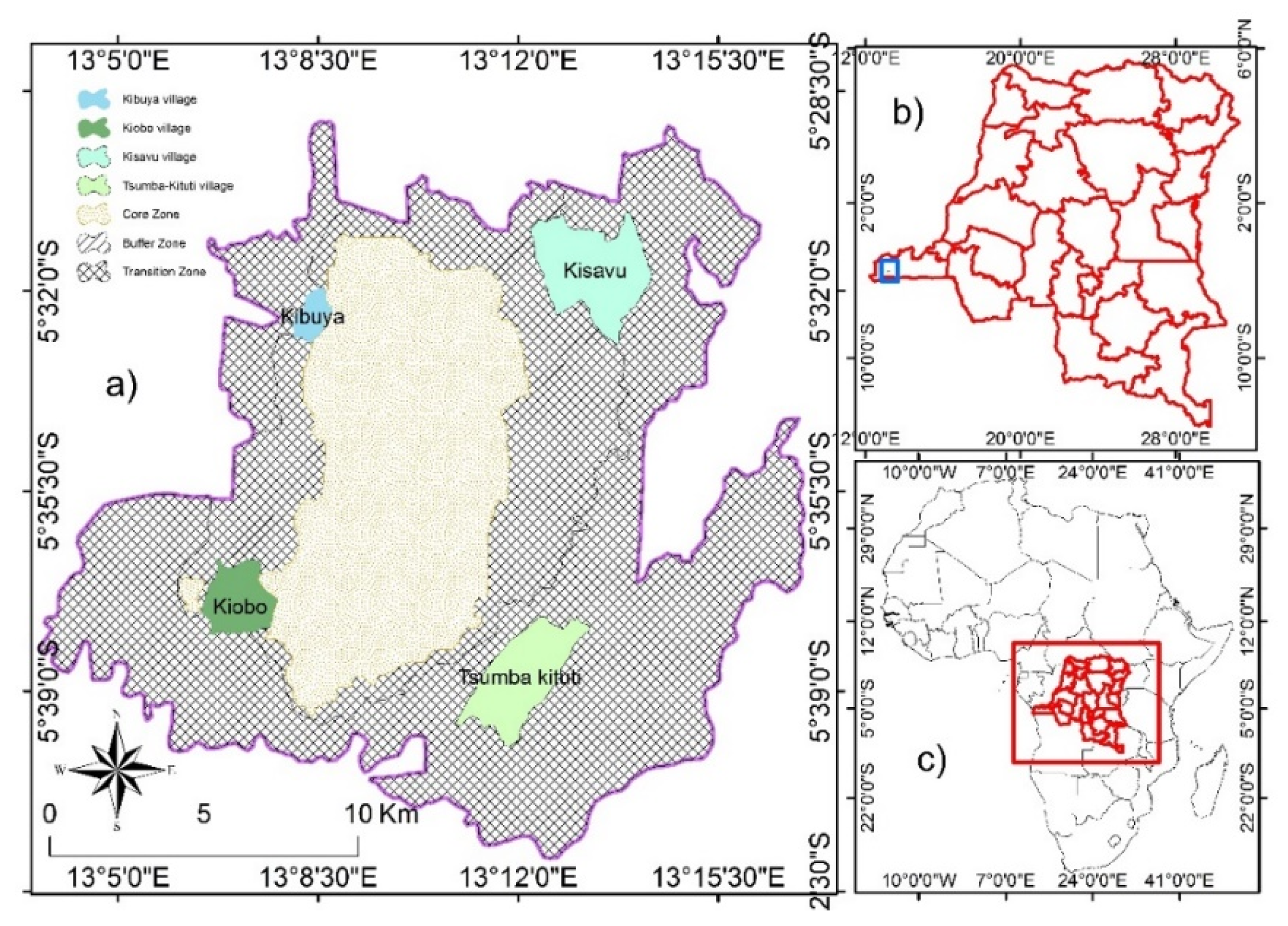
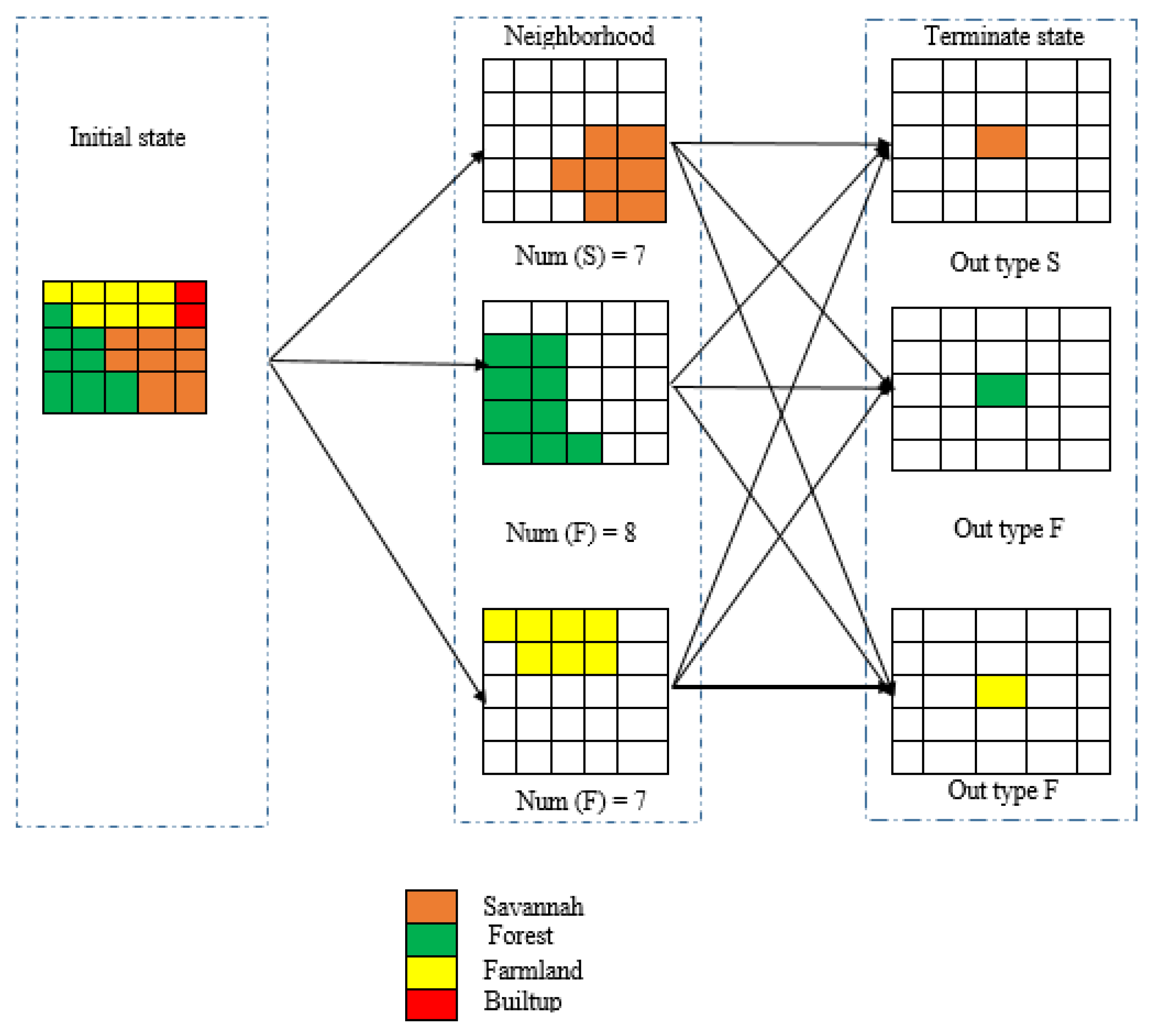
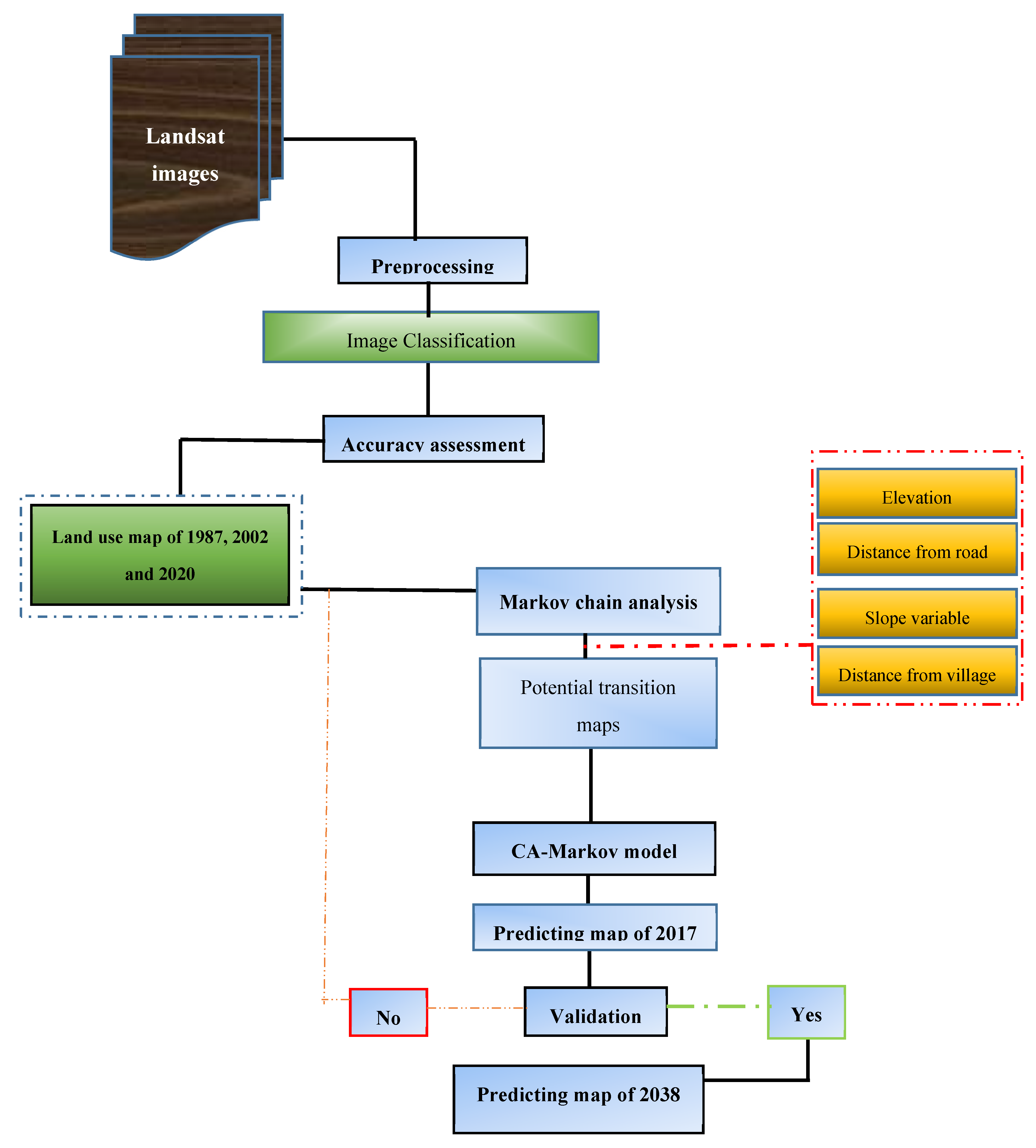
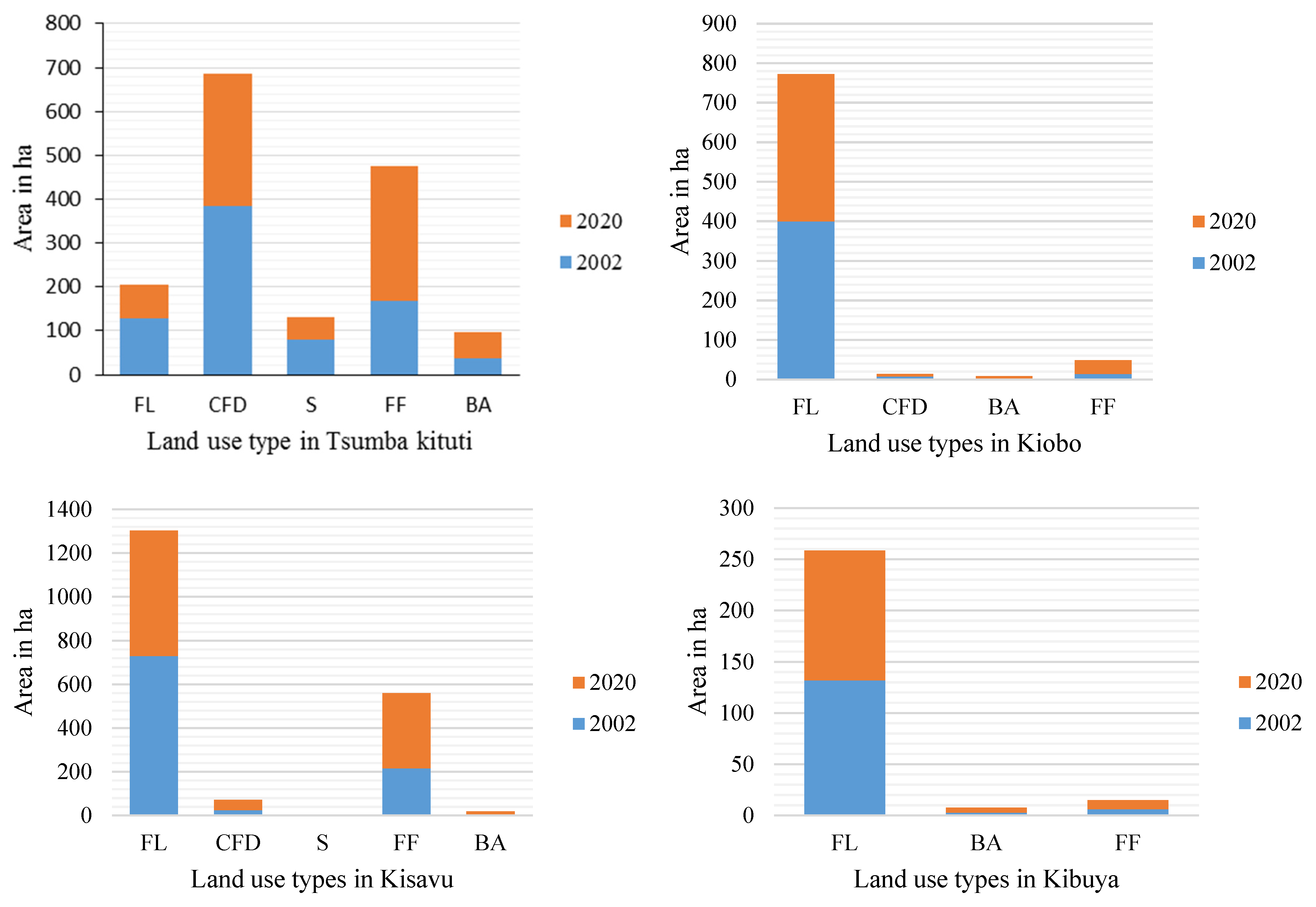
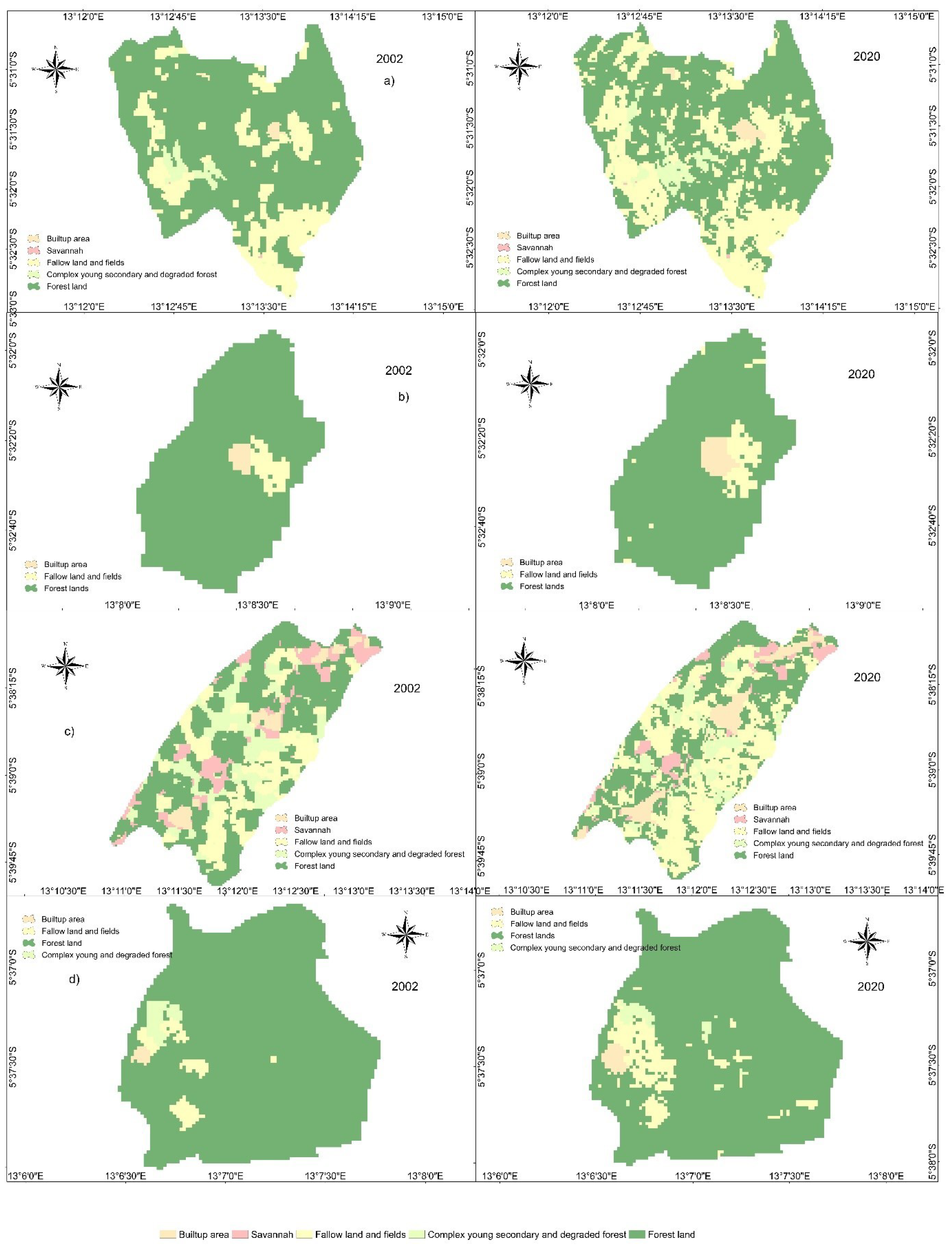
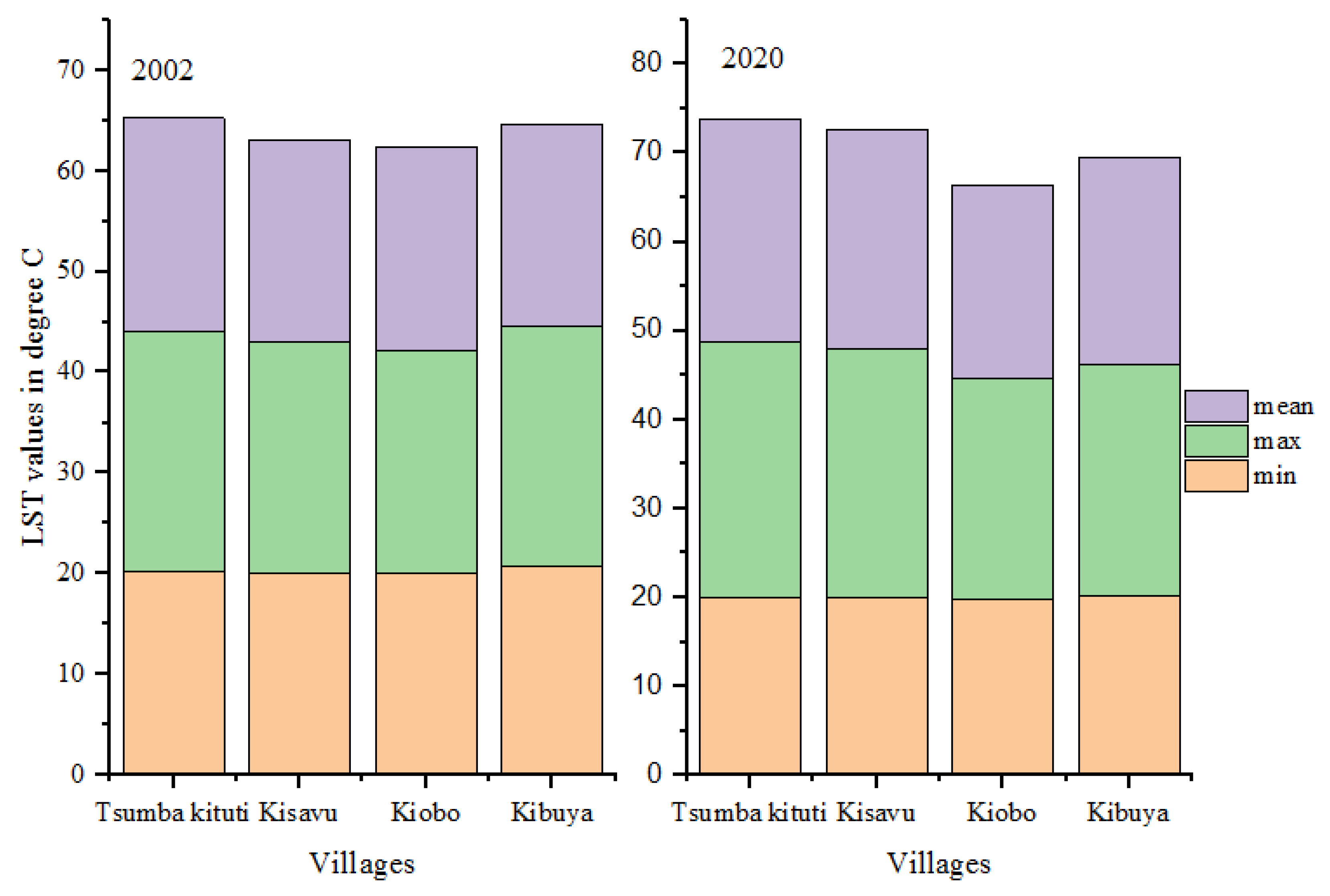
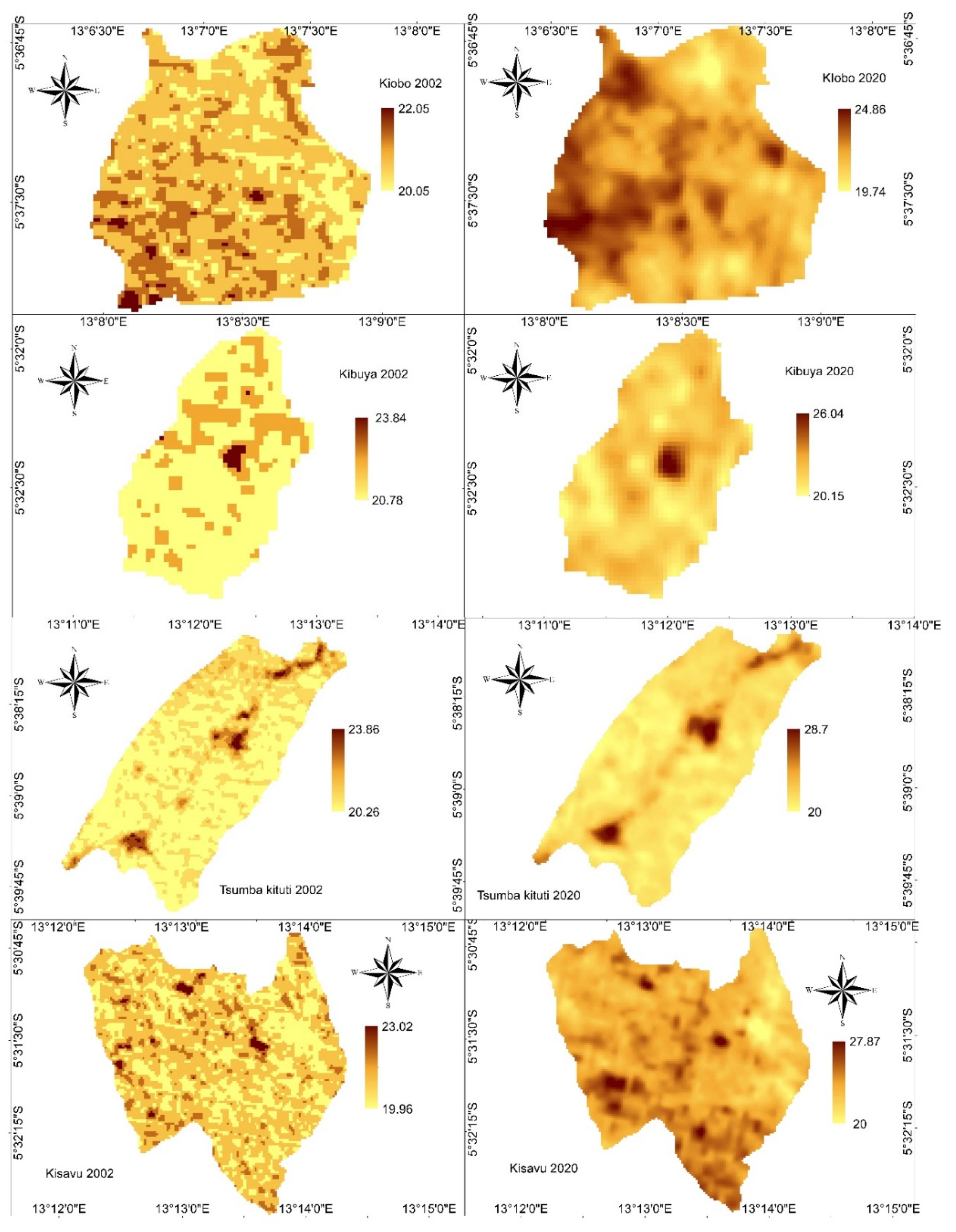
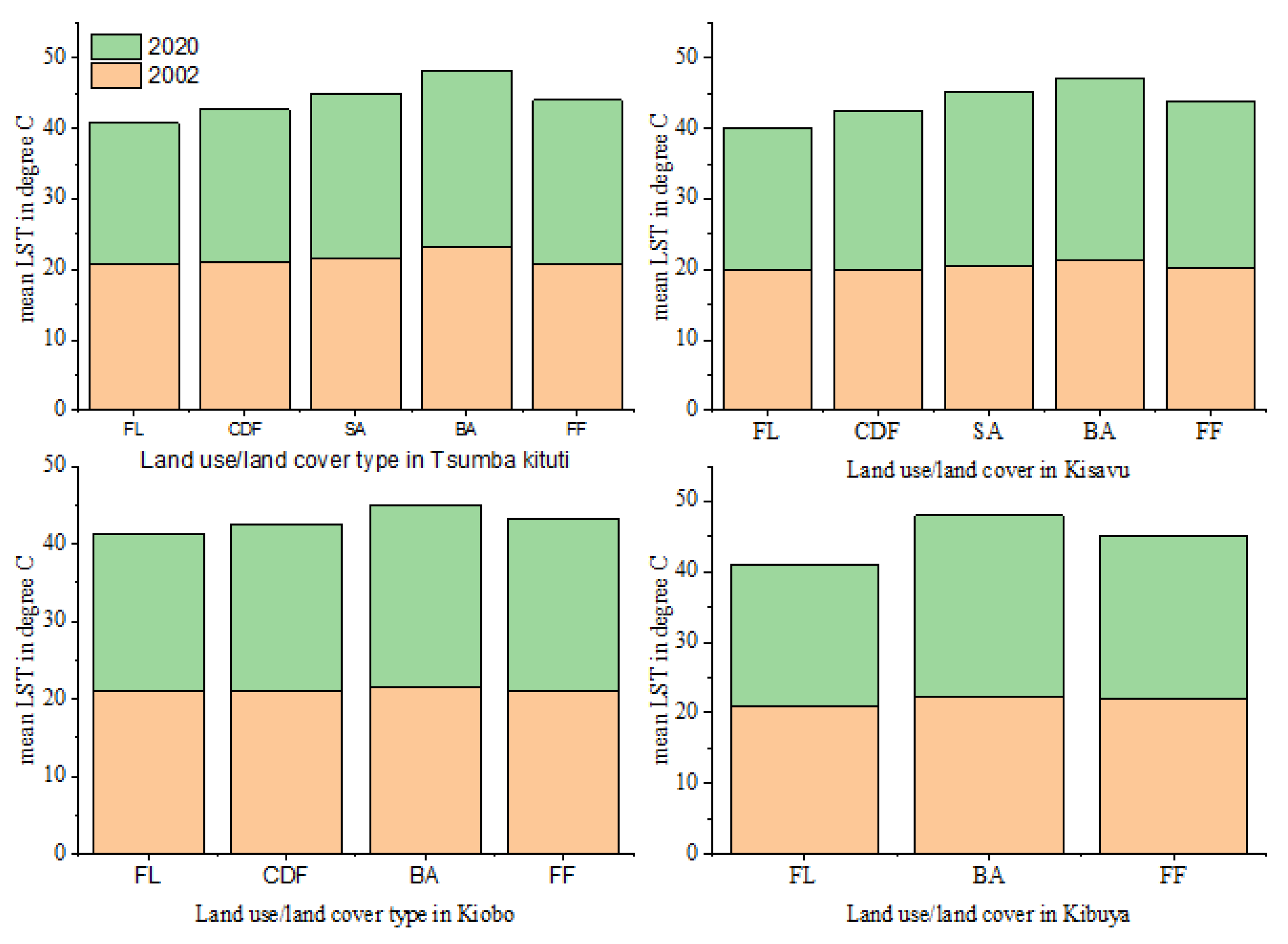
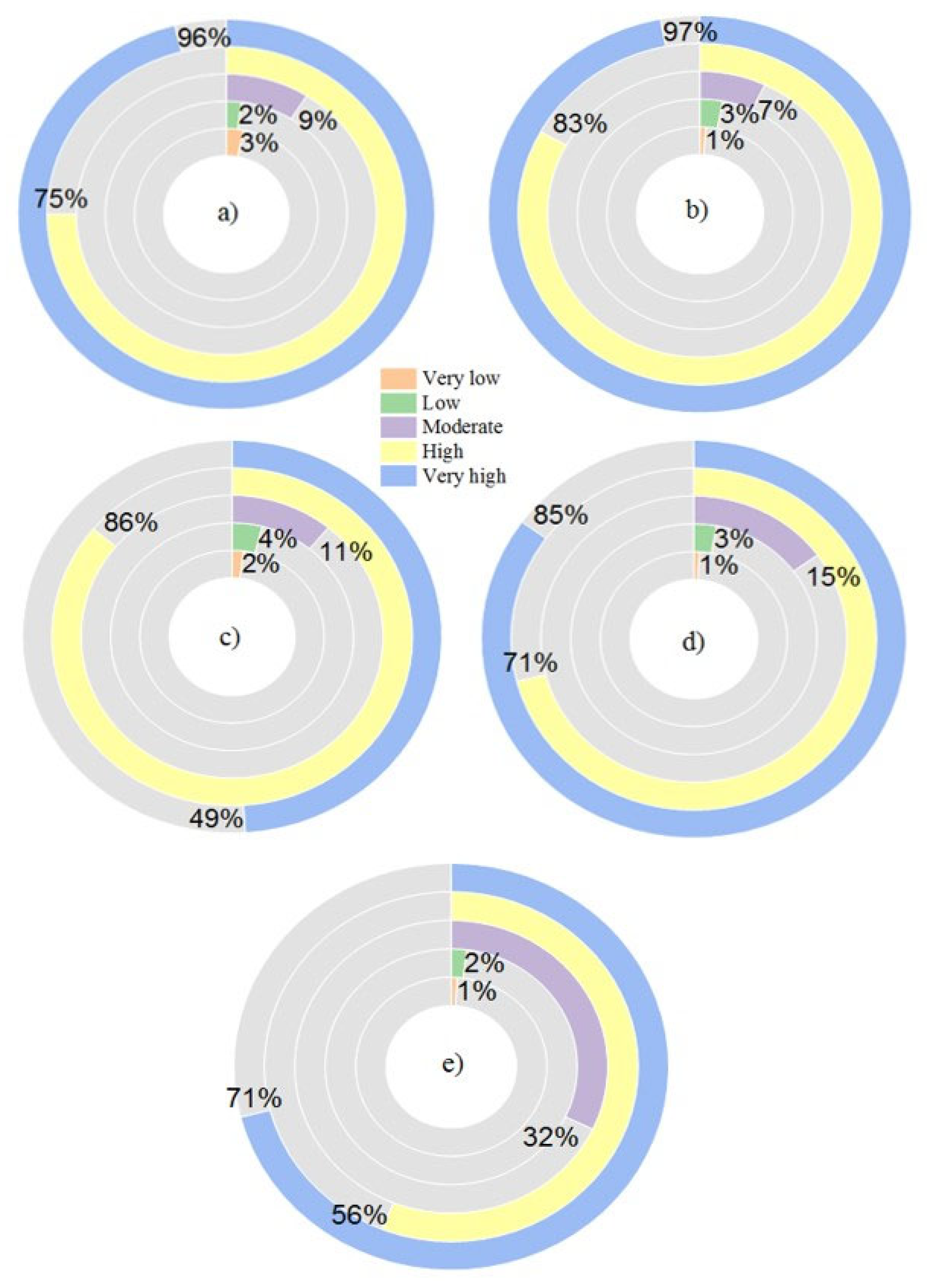
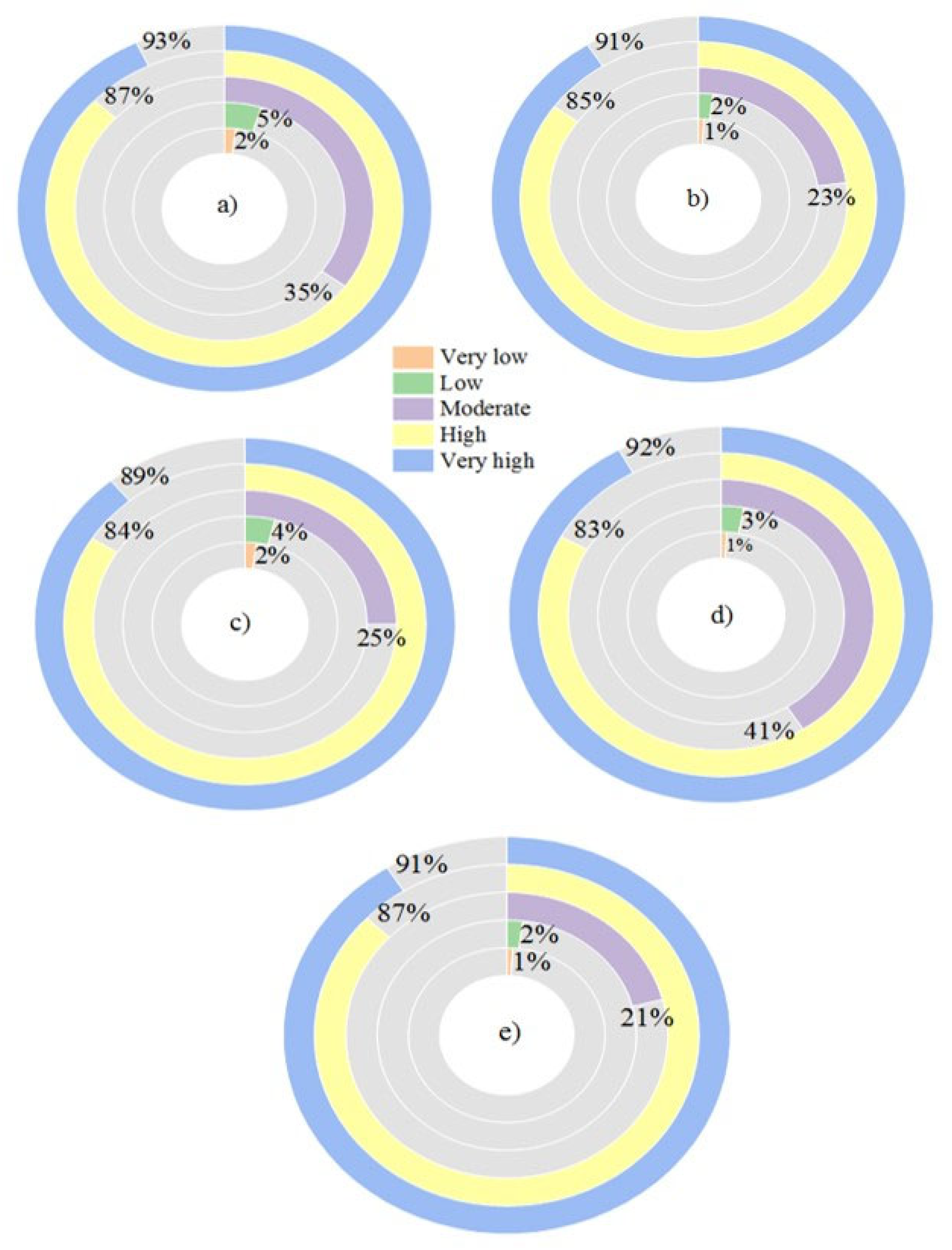
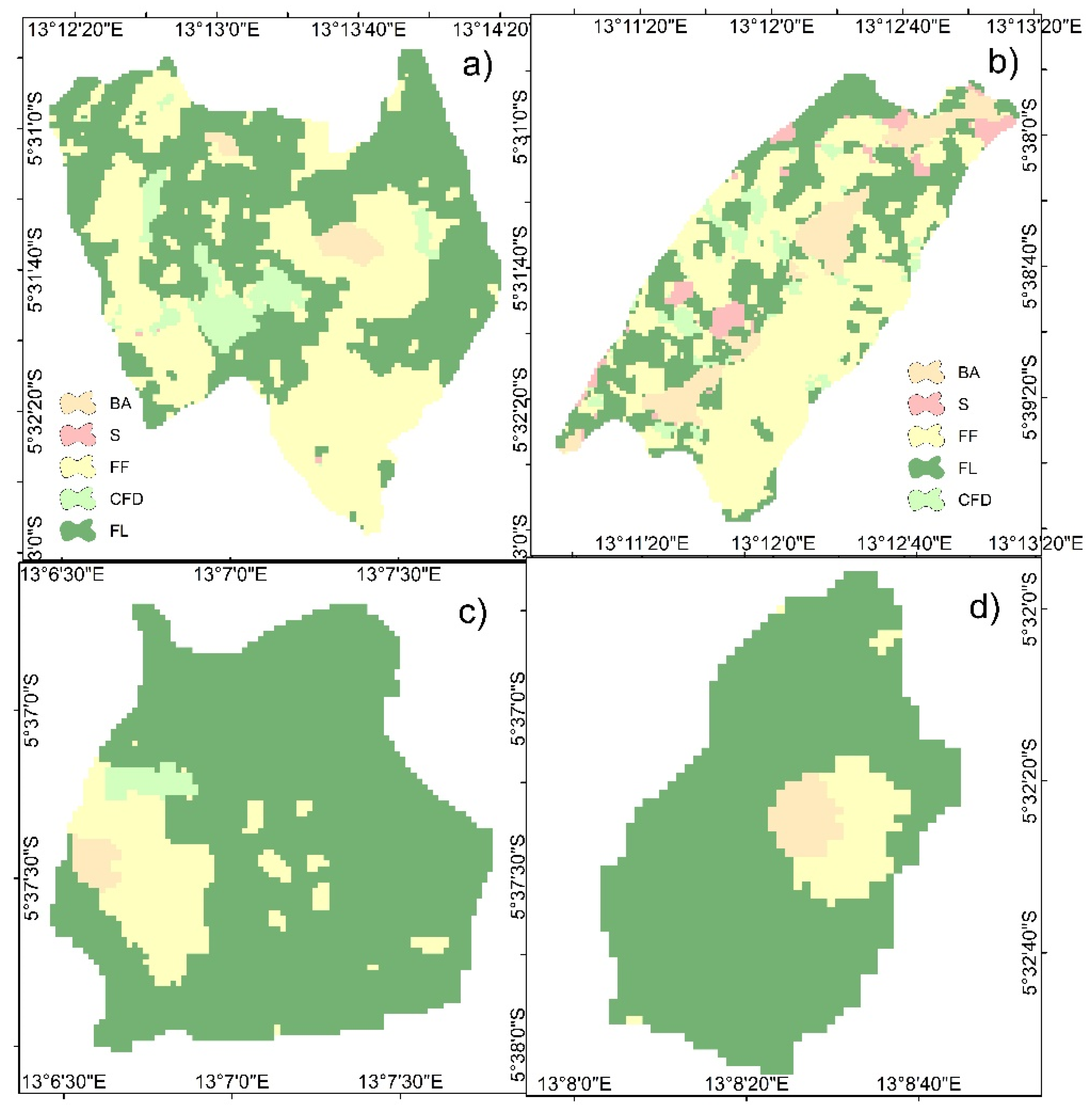
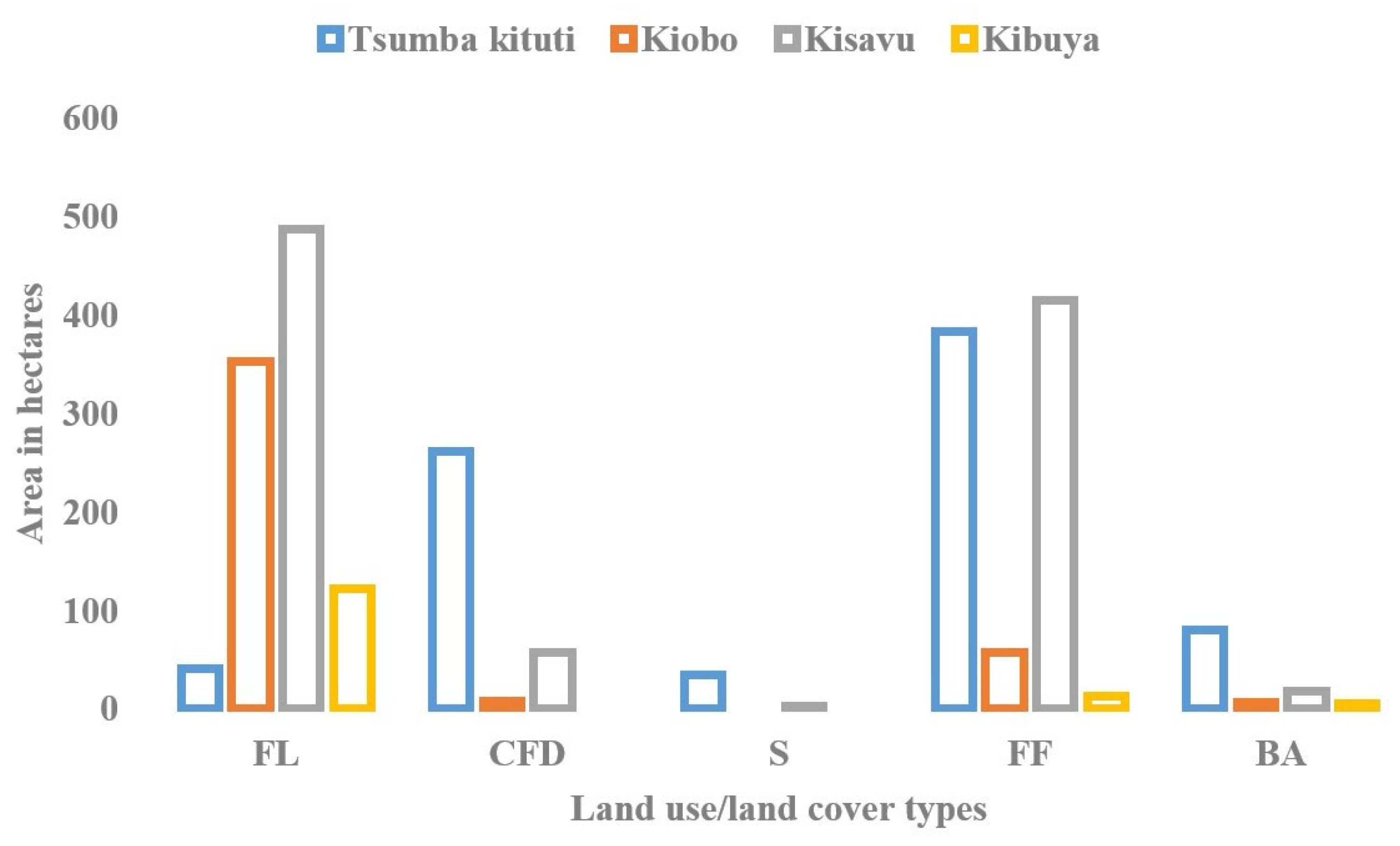
| Data Type | Name | Pixel Size | Wavelength | Description | Year |
|---|---|---|---|---|---|
| Landsat 7 ETM+ | B1 | 30 meters | 0.45–0.52 µm | Blue | 2002 |
| B2 | 30 meters | 0.52–0.60 µm | Green | ||
| B3 | 30 meters | 0.63–0.69 µm | Red | ||
| B4 | 30 meters | 0.77–0.90 µm | Near infrared | ||
| B5 | 30 meters | 1.55–1.75 µm | Shortwave infrared 1 | ||
| B6 | 30 meters | 10.40–12.50 µm | Low-gain Thermal Infrared 1 | ||
| B6 | 30 meters | 10.40–12.50 µm | High-gain Thermal Infrared 1 | ||
| B7 | 30 meters | 2.08–2.35 µm | Shortwave infrared 2 | ||
| B8 | 15 meters | 0.52–0.90 µm | Panchromatic | ||
| Landsat 8 OLI/TIRS | B1 | 30 meters | 0.43–0.45 µm | Coastal aerosol | 2020 and 2017 |
| B2 | 30 meters | 0.45–0.51 µm | Blue | ||
| B3 | 30 meters | 0.53–0.59 µm | Green | ||
| B4 | 30 meters | 0.64–0.67 µm | Red | ||
| B5 | 30 meters | 0.85–0.88 µm | Near infrared | ||
| B6 | 30 meters | 1.57–1.65 µm | Shortwave infrared 1 | ||
| B7 | 30 meters | 2.11–2.29 µm | Shortwave infrared 2 | ||
| B8 | 15 meters | 0.52–0.90 µm | Band 8 Panchromatic | ||
| B9 | 15 meters | 1.36–1.38 µm | Cirrus | ||
| B10 | 30 meters | 10.60–11.19 µm | Thermal infrared 1 | ||
| B11 | 30 meters | 11.50–12.51 µm | Thermal infrared 2 |
| Name of Component | CA–Markov Model | |||
|---|---|---|---|---|
| Tsumba kituti | Kisavu | Kibuya | Kiobo | |
| Persistence simulated correctly | 96.11% | 95.82 | 96.62 | 96.91 |
| Change simulated correctly | 0.81% | 0.79 | 0.89 | 1.11 |
| Total agreement | 96.92% | 96.61 | 97.51% | 98.02% |
| Change simulated as persistence | 1.72% | 1.81 | 1.41 | 1.34 |
| Persistence simulated as change | 1.33% | 1.42 | 1.06 | 0.61 |
| Change simulated as change to incorrect category | 0.03% | 0.16 | 0.02 | 0.03 |
| Total disagreement | 3.60% | 3.39 | 2.49 | 1.98 |
| Land-Use/Land-Cover Types | Mean LST in 2002 | Mean LST in 2020 | Change in °C | |
|---|---|---|---|---|
| Tsumba Kituti | Forest land to built-up area | 20.9 | 24.03 | 3.13 |
| Complex secondary and degraded forest to built-up area | 20.34 | 23.96 | 3.62 | |
| Complex secondary and degraded forest to fallow land and fields | 20.90 | 23.1 | 2.2 | |
| Fallow land to built-up area | 20.87 | 23.99 | 3.12 | |
| Forest land to fallow land and fields | 20.71 | 23.14 | 2.43 | |
| Kisavu | Forest land to built-up area | 20.5 | 23.75 | 3.25 |
| Complex secondary and degraded forest to built-up area | 20.61 | 23.52 | 2.91 | |
| Complex secondary and degraded forest to fallow land and fields | 20.72 | 22.89 | 2.17 | |
| Fallow land to built-up area | 20.23 | 24.12 | 3.89 | |
| Forest land to fallow land and fields | 20.21 | 23.28 | 3.07 | |
| Kiobo | Fallow land and fields to built-up area | 21.04 | 23.03 | 1.99 |
| Forest land to built-up area | 20.75 | 22.98 | 2.23 | |
| Forest land to fallow land and fields | 20.84 | 21.94 | 1.1 | |
| Complex secondary and degraded forest to fallow land and fields | 20.92 | 22.1 | 1.18 | |
| Kibuya | Fallow land and fields to built-up area | 21.94 | 24.68 | 2.74 |
| Fallow land and fields to Forest lands | 21.29 | 21.39 | 0.1 | |
| Forest land to built-up area | 20.97 | 24.61 | 3.64 | |
| Forest land to fallow land and fields | 21.11 | 21.36 | 0.25 |
Publisher’s Note: MDPI stays neutral with regard to jurisdictional claims in published maps and institutional affiliations. |
© 2021 by the authors. Licensee MDPI, Basel, Switzerland. This article is an open access article distributed under the terms and conditions of the Creative Commons Attribution (CC BY) license (https://creativecommons.org/licenses/by/4.0/).
Share and Cite
Opelele Omeno, M.; Yu, Y.; Fan, W.; Lubalega, T.; Chen, C.; Kachaka Sudi Kaiko, C. Analysis of the Impact of Land-Use/Land-Cover Change on Land-Surface Temperature in the Villages within the Luki Biosphere Reserve. Sustainability 2021, 13, 11242. https://doi.org/10.3390/su132011242
Opelele Omeno M, Yu Y, Fan W, Lubalega T, Chen C, Kachaka Sudi Kaiko C. Analysis of the Impact of Land-Use/Land-Cover Change on Land-Surface Temperature in the Villages within the Luki Biosphere Reserve. Sustainability. 2021; 13(20):11242. https://doi.org/10.3390/su132011242
Chicago/Turabian StyleOpelele Omeno, Michel, Ying Yu, Wenyi Fan, Tolerant Lubalega, Chen Chen, and Claude Kachaka Sudi Kaiko. 2021. "Analysis of the Impact of Land-Use/Land-Cover Change on Land-Surface Temperature in the Villages within the Luki Biosphere Reserve" Sustainability 13, no. 20: 11242. https://doi.org/10.3390/su132011242
APA StyleOpelele Omeno, M., Yu, Y., Fan, W., Lubalega, T., Chen, C., & Kachaka Sudi Kaiko, C. (2021). Analysis of the Impact of Land-Use/Land-Cover Change on Land-Surface Temperature in the Villages within the Luki Biosphere Reserve. Sustainability, 13(20), 11242. https://doi.org/10.3390/su132011242







